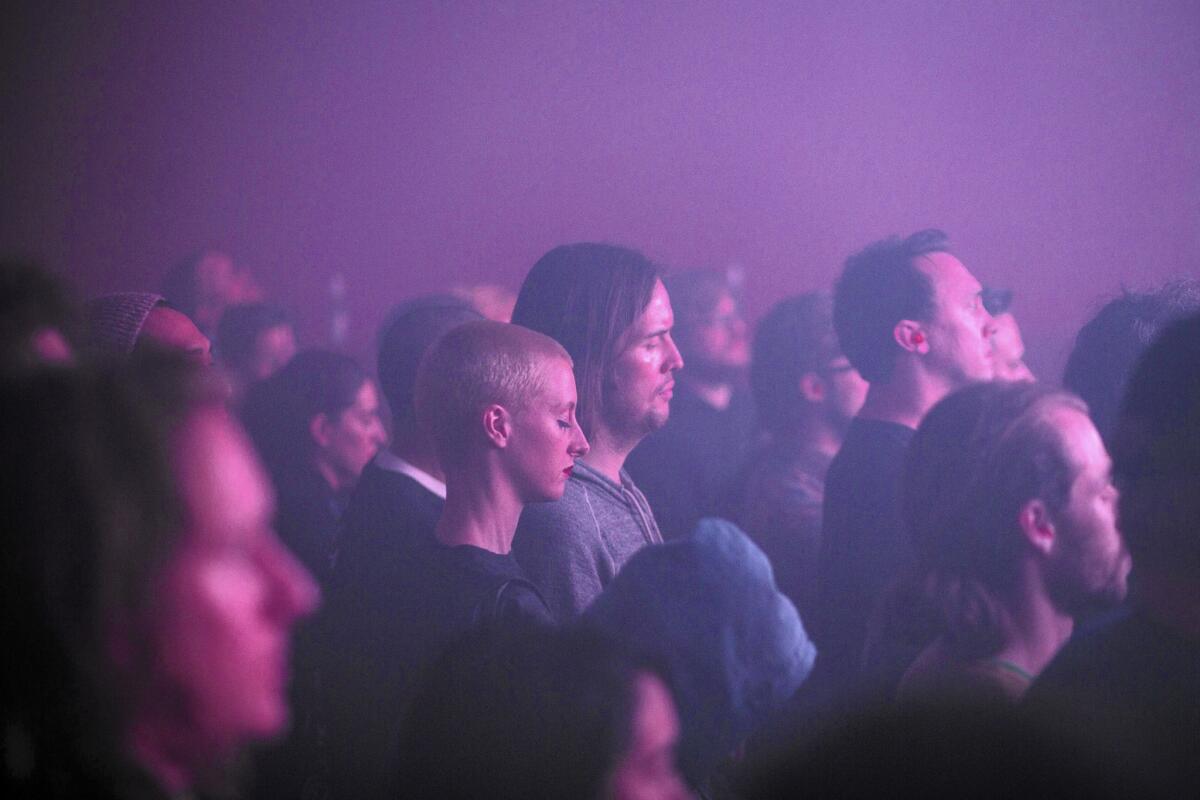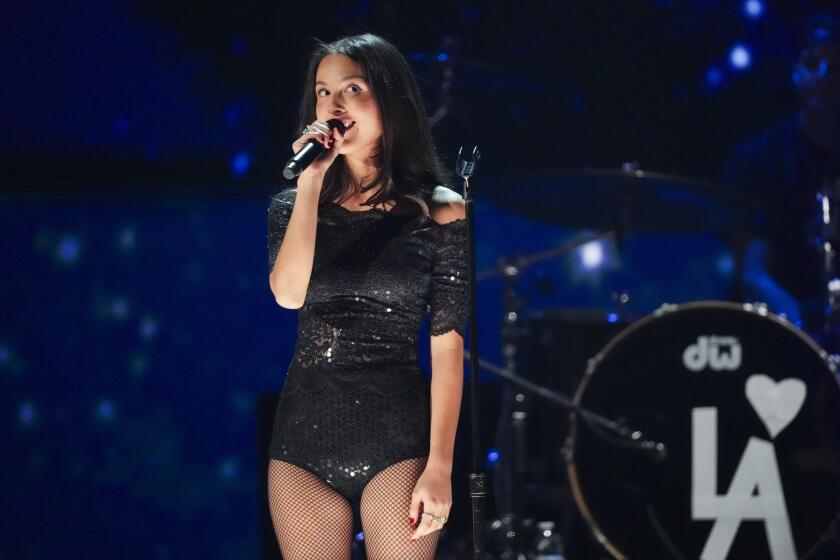Review: Three nights in L.A.: dancing gold flakes, Russian lounge music and William Basinski’s ‘The Deluge’

- Share via
On Wednesday night, in front of 30 people, a woman made flakes of gold levitate and dance at a small room in Echo Park’s South of Sunset. Her name was Evelina Domnitch, and she wore an off-white dress and shoes by United Nude that looked a bit like an infinity symbol rendered in white and green plastic. An orderly strip of hair bisected her otherwise shaved head.
Seventh-grade physics would be easier if there were more Domnitches and gold flakes.
With her partner Dmitry Gelfand adjusting unidentified signals from a mixing desk nearby, “Sonolevitation” (the name of the piece and the process) was a visual and aural experience. Two flat-ended silver tubes facing each other — imagine a highly polished pipe with a space in the middle cut out — were magnified and projected onto the wall. Between these tubes, Domnitch placed tiny laser-cut pieces of gold, which floated and spun. As they moved, the gold pieces seemed to alter the pitches, a blend of piercing and rich buzzing. The fragments did not generally touch, but when they did, there was joy in the collision. Two pieces fell to the surface of the lower tube at one point and danced around the edge, like a stop-motion animation of a shuffling golden Dorito.
SIGN UP for the free Essential Arts & Culture newsletter >>
It is a bit harder to explain how these flakes were dancing and how very low and very high tones were being produced. After the performance, Domnitch and Gelfand said via email that the magic was an empirical process: “A 15 kHz acoustic vibration is vertically reflected at a precise distance from its source, generating a standing wave that levitates leaves of gold. The air between the speaker and the reflector is evenly divided into alternating areas of dynamic acoustic pressure and vacuous anti-nodal pockets. Within these pressureless voids, fluids and solids can be suspended and spun by the surrounding sound fields.”
Standing waves are an event engineers try to avoid when designing spaces for recording and listening to music. This is why concert halls often have so many nonparallel surfaces and oddly slanted bits hanging on the walls and ceiling. Generally, an artist wants a sound to travel and then more or less bounce off something and get out of the way, because the sound coming next needs to take up space in the air and your brain. Standing waves create a sustained ringing that is generally regarded as lingering interference, unless you are a clever pair of Russians who figure out how to use that pattern to suspend objects.
“It is not magnets!” Domnitch said after the show. “The gold proves it. You can’t pick up gold with a magnet.”
Some of what made the presentation delightful was that we were not burdened with the normal armature of music (and film): linear narrative, melody, pretense of character. As Domnitch placed a flake into the sonic field with her tweezers, the fragments would sometimes spin and collide, fracturing the gentle balance of the sound waves. She would carefully pick them up again and place them in the invisible stream, while smiling (visibly). I wouldn’t know what category to put “Sonolevitation” in, except maybe Suspense Science or Tinnitus Cinema. The duo will return to L.A. in February to levitate blobs of liquid.
On Thursday night, the pair hosted a party at one of the most L.A. places in L.A. The Barn — a barn (reassuring, that) — was remodeled in 1965 by midcentury modern architect A. Quincy Jones. Though outfitted in the warm wood paneling and thin, repeating slats that typify his work, it is ironically huge, nothing like a standard, one-story A. Quincy Jones house design. The barn was bought in 2009 by the Annenberg Foundation and restored; it is used now for artist residencies. The restoration is so complete that the office drawers still hold the electric typewriter balls used by Jones’ wife, Elaine, to type out the party invitations that are also intact. (On Oct. 1, 1976, the couple hosted faculty and staff of the USC Architecture and Fine Arts department.)
Being in the church of midcentury modernism led to a fairly obvious conclusion that “Mad Men” had watermarked that look. It is hard to eat ham in a house with clean lines and stepped floors and not think of a Draper. Co-hosted by composer William Basinski, who lives in Mar Vista and is not above doing dishes, the party was calmly festive. Gelfand played kitschy electronic Russian lounge music over the house’s built-in speaker system. (There’s a panel in the master bedroom that includes a button that says simply, “house music.”) At one point, Domnitch and another woman executed a stately ballroom dance to the twinkling. Jones would have liked the combination of elegance and mild dissonance.
On Friday night, the Ninja Tune label marked its 25th anniversary by presenting a show at the Masonic Lodge at Hollywood Forever Cemetery. (I was hoping we might be nestled among tombstones, watching musicians perched on sarcophagi. Nope.) The lodge is a formal box, with cushioned pews running around the perimeter, and red velvet curtains framing the stage.
Basinski appeared again, this time as a performer. With his portable reel-to-reel tape decks and a laptop, he presented “The Deluge.” Like most of his work, it is a sublime and tricky beast, generated from a tape loop of piano playing recorded decades ago. Basinski altered the amounts of echo and feedback applied to the loop, and it all ended up being slightly louder than his regular performances. (I couldn’t swear to it, but standing waves might have formed between the parallel walls of the lodge.) As the loops heated up and began to soften one’s sense of time, the music faded and returned for a denouement that was flecked with one wayward blast and then went into a brief orchestral loop that Basinski normally uses to close the piece. After taking a bow, Basinski presented us with what he called a “Christmas gift.” He played “1.3,” from his best-known work, “The Disintegration Loops.” I had never seen anybody whoop loudly when hearing this music, which is a horn or string section slowly cycling through four notes at what feels like a great distance. But now I have.
The evening closed with a fog. After the room was pumped full of artificial haze, and sightlines were reduced, Liz Harris (also know as Grouper) and Kevin Martin (known for the evening as the Bug, one of several aliases) took the stage. The blockage of the smoke worked like a visual volume knob: The performers simply faded into view. Harris sang through a layer of effects and played a sparse motif that might have been a sample of bells. Martin provided a thunderously low two-note horn figure and then what could have been a dance-hall rhythm as imagined by Basinski: degraded and submerged. The piece was titled “Sirens (A Symphony for Foghorn, Bass Drone, Siren and Extreme Volume),” which clears up any confusion.
Through it all, a siren did wail, growing less alarming as the volume built. The piece was as careful in its accretion as Basinski’s, though rooted in heavily transformed elements of popular music. The section with Harris and Martin ended so gradually that some people assumed the evening was over and headed for the exits after Harris left the stage. After several minutes of quiet white noise from Martin, Dylan Carson of Earth took Harris’ place onstage. He played simple distorted guitar figures while Martin manipulated a waterlogged drum pattern from two turntables. It was an appropriate end to an uncanny week, as if several bands had been stretched in a pasta roller, cut apart and then left on a low boil.
--------------------
FOR THE RECORD
Dec. 14, 6:47 a.m.: An earlier version of this review stated incorrectly that artist Evelina Domnitch wore a sleeveless dress at her Wednesday-evening performance. The dress had sleeves. It was at the Thursday-night event, also discussed in the review, that her dress was sleeveless.
-------------------
More to Read
The biggest entertainment stories
Get our big stories about Hollywood, film, television, music, arts, culture and more right in your inbox as soon as they publish.
You may occasionally receive promotional content from the Los Angeles Times.










